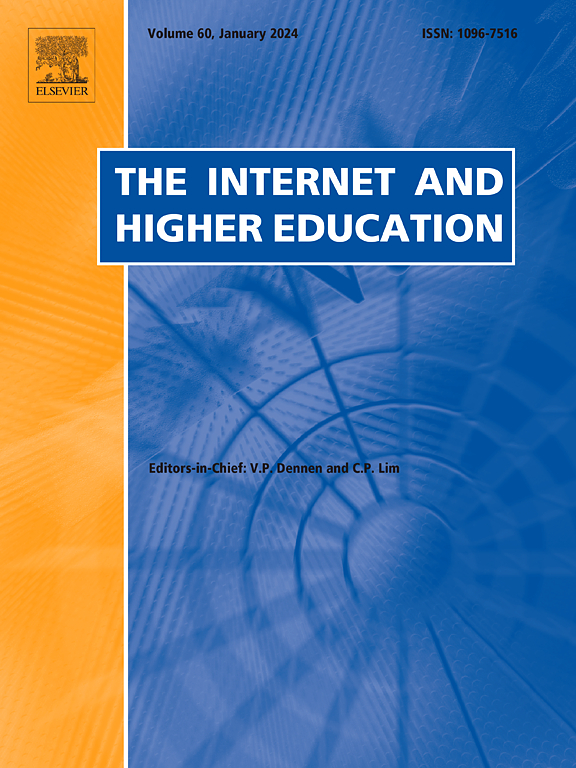远程呈现机器人对群体条件和学生参与的影响:高等教育中的混合方法研究
IF 6.8
1区 教育学
Q1 EDUCATION & EDUCATIONAL RESEARCH
引用次数: 0
摘要
利用团队学习理论,本文研究了远程呈现机器人是否以及如何影响混合教室中研究生合作的小组条件和学生参与度。混合教室面临着挑战,例如存在的不对称,影响远程和现场学生之间的协作学习。在两个理学硕士课程的17个混合教室中进行了实地实验。在八个实验组中,一个远程学生通过远程呈现机器人加入,而同一组的其他远程学生通过智能屏幕参与。在九个对照组中,所有远程学生都只通过智能屏幕参与。对156名学生的短期纵向调查数据的分析表明,使用远程呈现机器人的实验组的学生报告了更高水平的社会凝聚力、心理安全感和群体效力,特别是在课程的早期阶段。这些群体条件对学生的参与有积极影响。对10名现场学生的采访表明,远程呈现机器人通过物理体现增强了远程学生的存在感,并通过自主移动培养了赋权。这种减少的在场不对称促进了更多的自然互动,加强了群体条件:通过人际关系产生的社会凝聚力,通过减少参与障碍产生的心理安全感,以及通过增加知识共享产生的群体效力。远程呈现机器人还培养了现场学生的包容行为,通过他们对远程学生参与的回报和对他们作为协作学习的有价值贡献者的认可来驱动他们。这些发现促进了对团队学习和远程呈现机器人在混合教室环境中的作用的理解,促进了远程学生更有效的虚拟包容。本文章由计算机程序翻译,如有差异,请以英文原文为准。
The impact of a telepresence robot on group conditions and student engagement: A mixed-method study in higher education
Drawing on team learning theory, this paper examines whether and how a telepresence robot impacts group conditions and student engagement among graduate students collaborating within a hybrid classroom. Hybrid classrooms face challenges, such as an asymmetry of presence, compromising collaborative learning between remote and on-site students. A field experiment was conducted with 17 hybrid classrooms across two Master of Science courses. In the eight experimental groups, one remote student joined via a telepresence robot, while any additional remote students in the same group participated via the smart screen. In the nine control groups, all remote students participated solely via the smart screen. Analysis of short-term longitudinal survey data from 156 students indicated that students in experimental groups with a telepresence robot reported higher levels of social cohesion, psychological safety and group potency, especially in the early course stages. These group conditions positively influenced student engagement. Interviews with ten on-site students reveal that the telepresence robot enhanced remote students' presence through physical embodiment and fostered empowerment via autonomous mobility. This reduced presence asymmetry facilitated more natural interactions, reinforcing group conditions: social cohesion through interpersonal connections, psychological safety through reduced participation barriers, and group potency through increased knowledge sharing. The telepresence robot also fostered inclusive behavior among on-site students, driven by their reciprocation of remote students' engagement and recognition of them as valuable contributors to collaborative learning. These findings advance understanding of team learning and the role of telepresence robots in hybrid classroom settings, promoting more effective virtual inclusion for remote students.
求助全文
通过发布文献求助,成功后即可免费获取论文全文。
去求助
来源期刊

Internet and Higher Education
EDUCATION & EDUCATIONAL RESEARCH-
CiteScore
19.30
自引率
4.70%
发文量
30
审稿时长
40 days
期刊介绍:
The Internet and Higher Education is a quarterly peer-reviewed journal focused on contemporary issues and future trends in online learning, teaching, and administration within post-secondary education. It welcomes contributions from diverse academic disciplines worldwide and provides a platform for theory papers, research studies, critical essays, editorials, reviews, case studies, and social commentary.
 求助内容:
求助内容: 应助结果提醒方式:
应助结果提醒方式:


